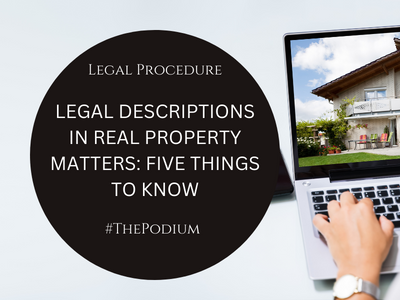
Does this sound familiar? Two legal secretaries sitting side-by-side, both holding identical documents, while one reads the document verbatim (punctuation and all) as the other checks their copy to ensure that what is being read out loud is EXACTLY what is typed on the document. If so, then chances are you have either been one of those legal secretaries or you have witnessed the act of ensuring the accuracy of a real property legal description.
The legal description includes a written description of the property and other information that helps to identify it on a map. It can look a bit daunting, especially with all the jumble of letters, numbers, and abbreviations, but that information is integral to real estate transactions. The legal description can be used to help provide historical details for a piece of property as well as the assessment and taxation of the property.
Listed below are five things to know when it comes to legal descriptions and assisting your clients with real property transactions.
The description must be complete enough that it would enable a professional surveyor to locate and identify the land. An accurate legal description is essential for property transfers. This is especially pertinent for property that has changed hands numerous times in the past but is just as essential for new construction. An incorrect description, unnoticed or ignored for years, can result in boundary disputes, title problems, the construction of improvements on the wrong property, and could permanently alter the boundary lines of a property. A deed with an incomplete or incorrect legal description is not enforceable in a court of law. The legal description is kept with the deed and filed with the county clerk or county tax accessor. You’ll need the legal description for any sales contracts, deeds, and mortgages.
Sometimes clients/landowners will confuse the legal descriptions with other descriptions of the property, like their street address or the description shown in the property tax records. It’s important to remember that the legal description is the only one that is legally sufficient to transfer the described property. When the legal description (and the information that is supposed to be contained in it) is incorrectly stated on the deed, the wrong piece of real estate will be transferred from the previous owner to the new owner. When preparing a legal description, you’ll want to use the exact legal description that appeared on the most recent deed to the property.
As mentioned above, avoid using the property tax record description, which is often brief and inadequate when it comes to legally describing the property. The street address is also far short of a legal description because these are unreliable and can change. In short, never substitute another description for the true legal description!
Knowing how to read the legal description of a property is a skill many clients, landowners, and property buyers overlook, and one which they rely on their attorneys to understand. That said, before your client moves forward with any sale, be sure your attorney or the agent handling the sale has verified how old the legal description is. If the legal description has been copied and pasted from an outdated survey, especially if it has been passed down over many years between family members, it’s worth the client’s time and money to hire a land surveyor that can update this information.
Why does the legal description matter? Because having an incorrect legal description means your client may not receive the right parcel of land. At the end of the day, you own what is written in the legal description of your deed. If this is incorrect, then you don’t legally own what you think you do.
Understanding the significance of the legal description and the effect of its accuracy is key to providing your clients with efficient legal representation. Your role in assisting the attorney and the client with real estate or real property transactions is critical to ensuring that the transaction is conducted professionally and accurately.
Categorized in: Legal Procedure
| << previous | next >> |








